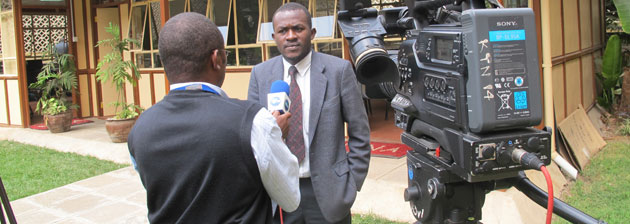Thursday, 06 Jun 2013
A big step back for media freedom in Kenya
0
0

By Boni Odinga, Internews in Kenya.
The media could become part of the casualties in the ongoing protracted battle pitting the National Assembly against the Salaries and Remuneration Commission(SRC).Journalists have been asked to vacate the media center within the House precincts. Following the surprise move, parliamentary journalists could be seen both within and outside the grounds bemoaning the development. The two very territorial estates, joined at the hip, seem to be headed for a showdown.
“This is surely a return to the KANU dark days”, Kiss TV’s Shem Oluchiri and NTV’s Ken Mijungu said as they tried to come to terms with the happening.
According to the journalists, the plan was hatched two weeks ago after it emerged that journalists were giving too much coverage to the demonstrations outside Parliament. The demos, since dubbed the ‘pig protests’ had civil society activists dump pigs and feed outside the national assembly in protest at MPs intention to award themselves a hefty salary hike, annulling what had been set by the Sarah Serem-led Salary Remuneration Commission.
The National Assembly Clerk Justin Bundi said that they will not give residence to journalists; a tacit reference to the media center that hosts parliamentary reporters. According to the clerk, the scribes will only be invited to the House on a need to know basis. It is only the national broadcaster, KBC, that shall continue enjoying the rights to live coverage of the proceedings.
A rather dejected Nation Media Group journalist Caroline Wafula found it hard to come to terms with the development. “In this day and age, this shouldn’t happen, we’re not here on a joyride, we represent the public interest. Journalists will continue to first and foremost fight for the plight of Kenyans,” she said.
Terming it unfortunate Chairman of the Kenya Parliamentary Journalists Association Alphonce Shiundu said it would be hard to take on Parliament with its seemingly unfettered powers.
“These guys rarely lose,” Shiundu said rather resignedly. Shiundu also traced the turn of events to the MPs quest for more money and the tangent journalists seemed to have taken. “I think the MPs expect us to do for them PR, since we are accommodated within the precincts of the house.”
The clerk attributed the marching orders to the need for more committee rooms. The National Assembly has two main media centers. One in which press conferences are held but also used for House committee meetings and the second where journalists have access to computers and can quickly bang copy to beat deadlines. The centers were put up with grants from USAID through SUNY Kenya under the parliamentary strengthening programme. The two reclaimed rooms, if the new development holds sway, shall now be used for house departmental committees. This 11th National Assembly has four additional committees.
0
0
From the Data Journalism Blog
Google Fusion Tables: Adding a chart to map information window
Once data has been cleaned and uploaded to Google Fusion Tables, it is important that readers comprehend both the map and the data displayed about each geographical region when selected. A chart is one of the ways used to represent this region-by-region data for the readers. Google Charts make it Read more
Exploring the Use of Google Fusion Tables
Lots of media houses today take advantage of the power of Google in Fusing Tables to create interactive maps of data. It helps web viewers gain insight into information available on the map by fusing a geographical border file and data organized by those same geographical units. Google Fusion Tables Read more
Visualizing data using DataWrapper
DataWrapper is an online tool that helps anyone to create embeddable charts in minutes. The main advantages of using data wrapper are: a) It is easy to use. It saves on time needed to create an embeddable chart. b) User has full control. It is free software. You can choose Read more
Kenya leads decline in Female Genital Mutilation, but victims are younger, mutilation more extreme
Learn About Tableau A new report from UNICEF identifies Kenya among the top two countries, along with Central African Republic, in reducing the prevalence of Female Genital Mutilation (FGM). While Kenya is a leader, the data also reveals that remaining victims are younger, more severely brutalized and isolated to a Read more
Share this page
0
0
|